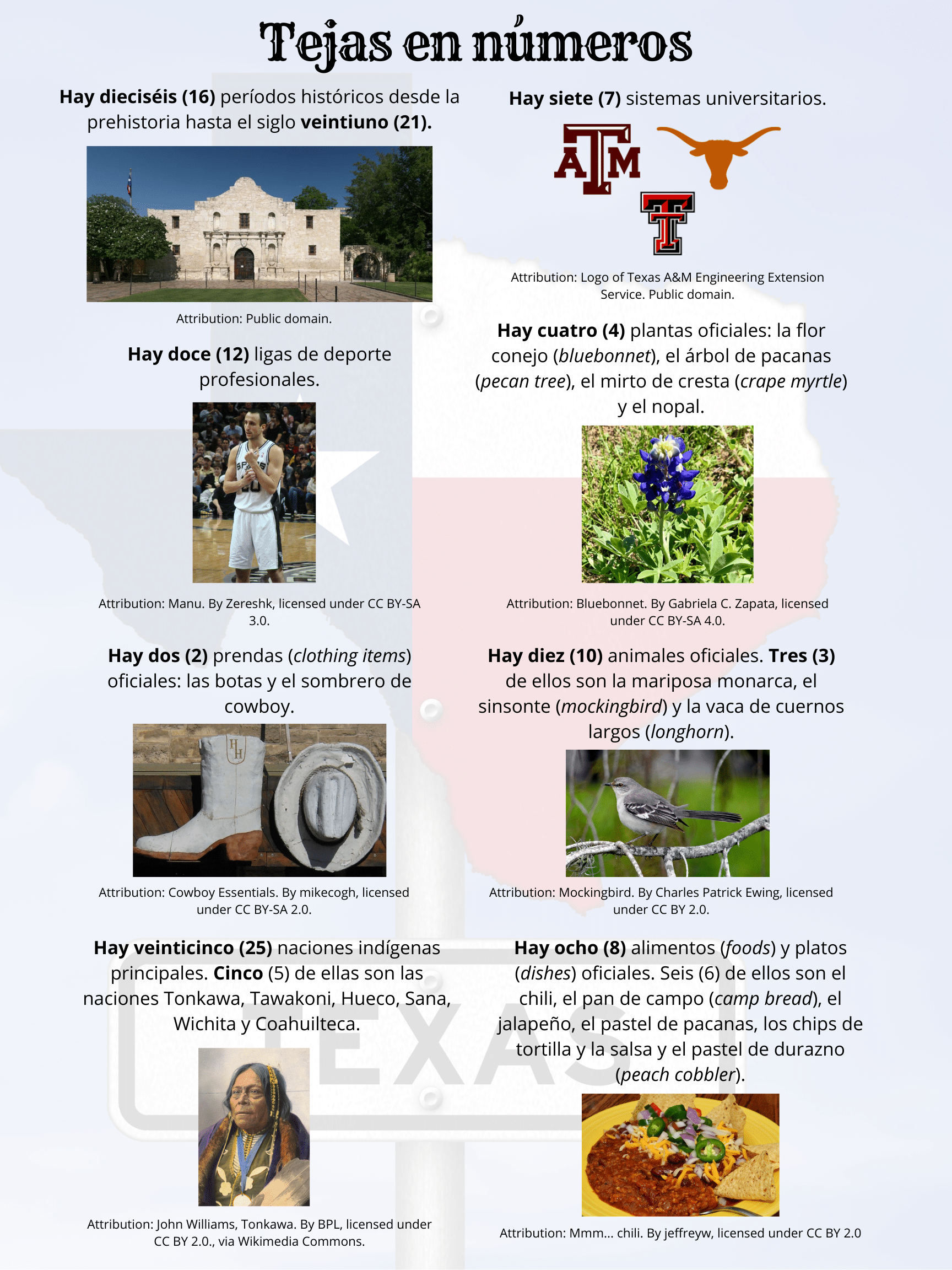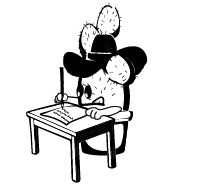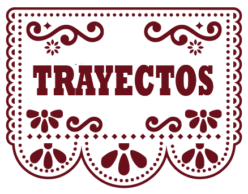Tejas en números: Uso y forma
In this section, we will use Spanish to talk about numbers (los números). To introduce the topic, we will focus on sociocultural and geographical/historical aspects of our state, Texas. What aspects do you think are the most interesting about the state? What does the information in the poster tell you about Texas?
While you are looking at the data, also pay attention to the verb hay. What do you think it means and how do we use it?

![]() El cactus viajero
El cactus viajero
In the south region of Texas and in other parts of the Spanish-speaking world, Spanish speakers refer to the mockingbird as cenzontle o chico.
Have you discovered what hay means and how we use it in Spanish? Yes, we use hay followed by a number to express the existence of people, animals, things, and places. It is equivalent to there is/there are in English, but hay is used on its own: It is not followed by any other verb (as you can see in the examples we have just seen). Let’s see how we ask questions using hay. It’s very easy.
¿Hay doce ligas profesionales de deportes en Tejas? Sí, hay doce ligas.
¿Cuántas plantas oficiales hay en Tejas? Hay cuatro.
If we want to use hay in a negative sentence, simply say no hay (e.g., No hay jirafas en Tejas.) Let’s have a look at numbers:
| 0 | cero | ||||
| 1 | uno | 11 | once | 21 | veintiuno |
| 2 | dos | 12 | doce | 22 | veintidós |
| 3 | tres | 13 | trece | 23 | veintitrés |
| 4 | cuatro | 14 | catorce | 24 | veinticuatro |
| 5 | cinco | 15 | quince | 25 | veinticinco |
| 6 | seis | 16 | dieciséis | 26 | veintiséis |
| 7 | siete | 17 | diecisiete | 27 | veintisiete |
| 8 | ocho | 18 | dieciocho | 28 | veintiocho |
| 9 | nueve | 19 | diecinueve | 29 | veintinueve |
| 10 | diez | 20 | veinte | 30 | treinta |
The number one has several forms in Spanish. When we are counting, we use the form uno (e.g., uno, dos, tres…). The forms una and un are used before nouns (e.g., una profesora, un profesor). How do you know which form to use? It will depend on the gender of the noun (feminine or masculine). We will talk about this in more detail in Módulo 1.
Another interesting number is twenty-one. It works like the number one. When we are counting, we say veintiuno. But we use veintiún before masculine nouns (e.g., veintiún profesores) and veintiuna before feminine nouns (e.g., veintiuna profesoras)
Now let’s actively use our new words.
 ¡Manos a la obra!
¡Manos a la obra!
![]() Actividad 0-9. La clases, la universidad y los Estados Unidos.
Actividad 0-9. La clases, la universidad y los Estados Unidos.
Paso 1. Imagine that a prospective international student from a Spanish-speaking country, Mariana, wants to know more about universities in the United State and the country itself. With a partner, answer the following questions about the typical university class, your university, and the United States. Take turns asking and answering questions.
- ¿Cuántos (How many) estudiantes hay en una clase típica de la universidad? ¿Cuántos días (days) de clase hay? ¿Cuántos días de vacaciones hay en el semestre de otoño (fall)? ¿Y en el semestre de primavera (spring)?
- En esta (this) universidad, hay muchos edificios (many buildings). Pero (But), ¿hay una cafetería? (Sí, hay… / No, no hay…) ¿Un teatro? ¿Un restaurante? ¿Una clínica? ¿Un hospital? ¿Un museo? ¿Una galería de arte? ¿Muchos estudiantes? ¿Muchos profesores?
- ¿Cuántos estados hay en el sur/norte/este/oeste de los Estados Unidos? ¿Cuántos parques nacionales y/o provinciales hay en Tejas/en tu estado? ¿Cuántos feriados (holidays) hay en los Estados Unidos? ¿Cuántos bares buenos (good bars) hay en esta ciudad (this city)? ¿Y cuántas discotecas buenas?
Paso 2. Now imagine that your partner and you write to Mariana with the information you gathered in Paso 1. You want to brag about the Spanish you know, so you decide to use this language to communicate with her. Draft the email you could send her. Include the following information:
- Greet the student;
- Introduce yourselves and say where you are from (use yo if you are from different places and nosotros if you are from the same place);
- Mention the name of the institution where you are university students (use nosotros);
- Describe the information you gathered.
Use the template below and the answers to the questions in Paso 1. Use the verb ser (don’t forget to conjugate it depending on the subject!). Use subject pronouns (e.g., yo, tú, etc.) when appropriate. Also, connect your ideas with y (and), o (or), también (also), además (also), and pero (but).
Estimada Mariana: [Greeting]. Mi nombre [ser] [Nombre] y mi nombre [ser] [Nombre]… En nuestra universidad, hay… en una clase típica. Las clases [ser] [number] o [number] días por semana… etc. ¡Hasta luego! [Nombre] y [Nombre]
Paso 3. Listen to your classmates’ emails. Do they have the same information as you and your partner? Does the class agree? Do you all know the university well?
![]() Actividad 0-10. Nuestro estado/ciudad/región.
Actividad 0-10. Nuestro estado/ciudad/región.
Paso 1. In this activity, you and three/four other students are going to create a digital, multimodal (text + images) poster similar to the one on Texas (Tejas en números). You can focus on your state, if you are not in Texas, or your city/region. You need to include 8 pieces of information with different numbers and a title. You can focus on Native American nations, languages, history, foods, universities, national parks, musicians, artists, etc. Use the Texas poster as your model.
To develop your poster, you can use free templates in platforms such as Canva (https://www.canva.com/) or Visme (http://bit.ly/VismeTool). Your images need to be open (i.e., copyright free). You can find this type of images using the search engine offered by Creative Commons (https://search.creativecommons.org/). Also, you need to provide attributions for all of them. To learn more about Creative Commons licenses and how to cite the open materials you find, see https://creativecommons.org/licenses/ and http://bit.ly/CreativeCommonsAttr.
Paso 2. Each group presents their poster in class. Each group member introduces themselves in Spanish (name, where they are from), and the group explains their choices.
What are some of the aspects of your state/city/region you did not know? Based on the team’s work, each team member will need to find an adjective in Spanish that describes the state/city/region on which you focused.
Click on the following button to continue using the verb hay and numbers 0-30.
Now it’s time to add more bones to our grammar skeleton! Let’s learn about question words:


